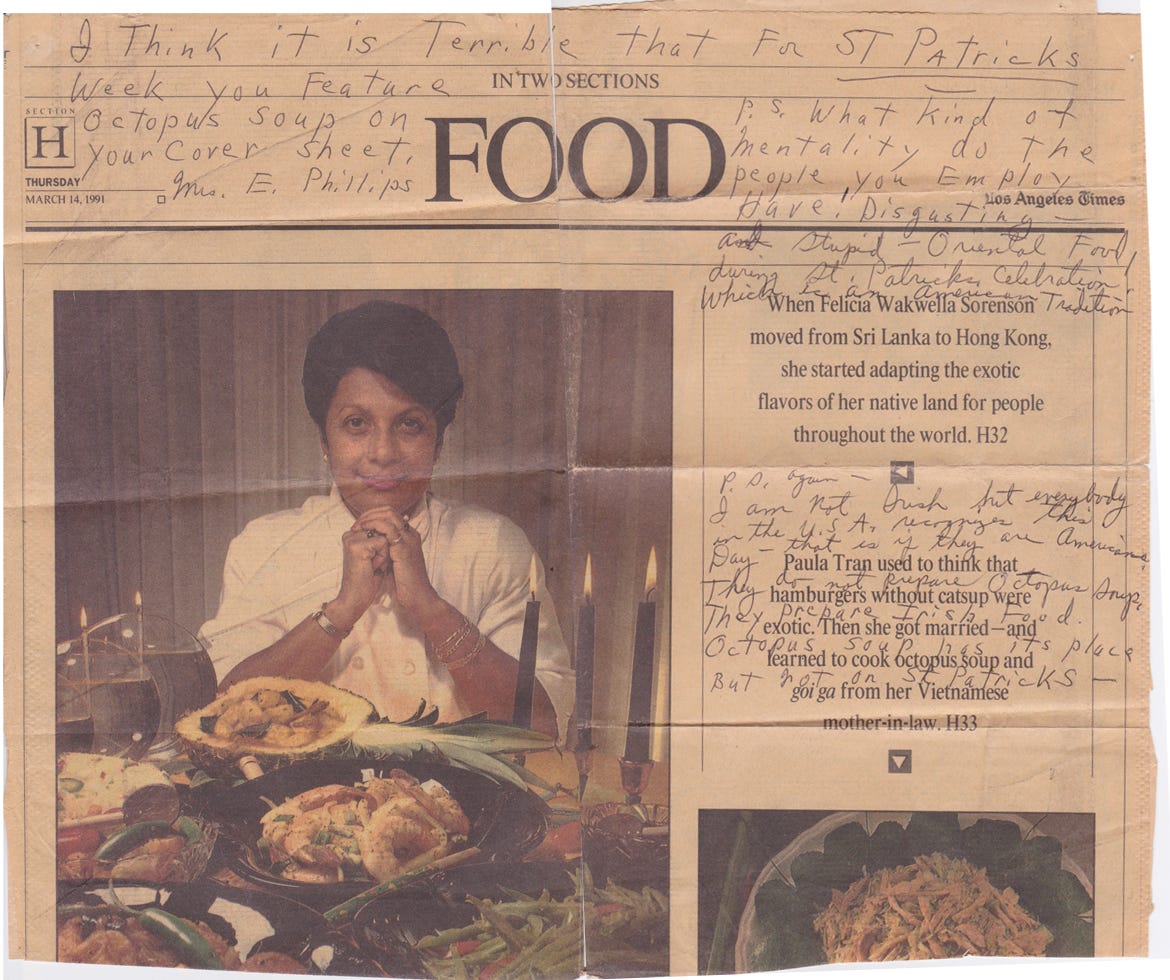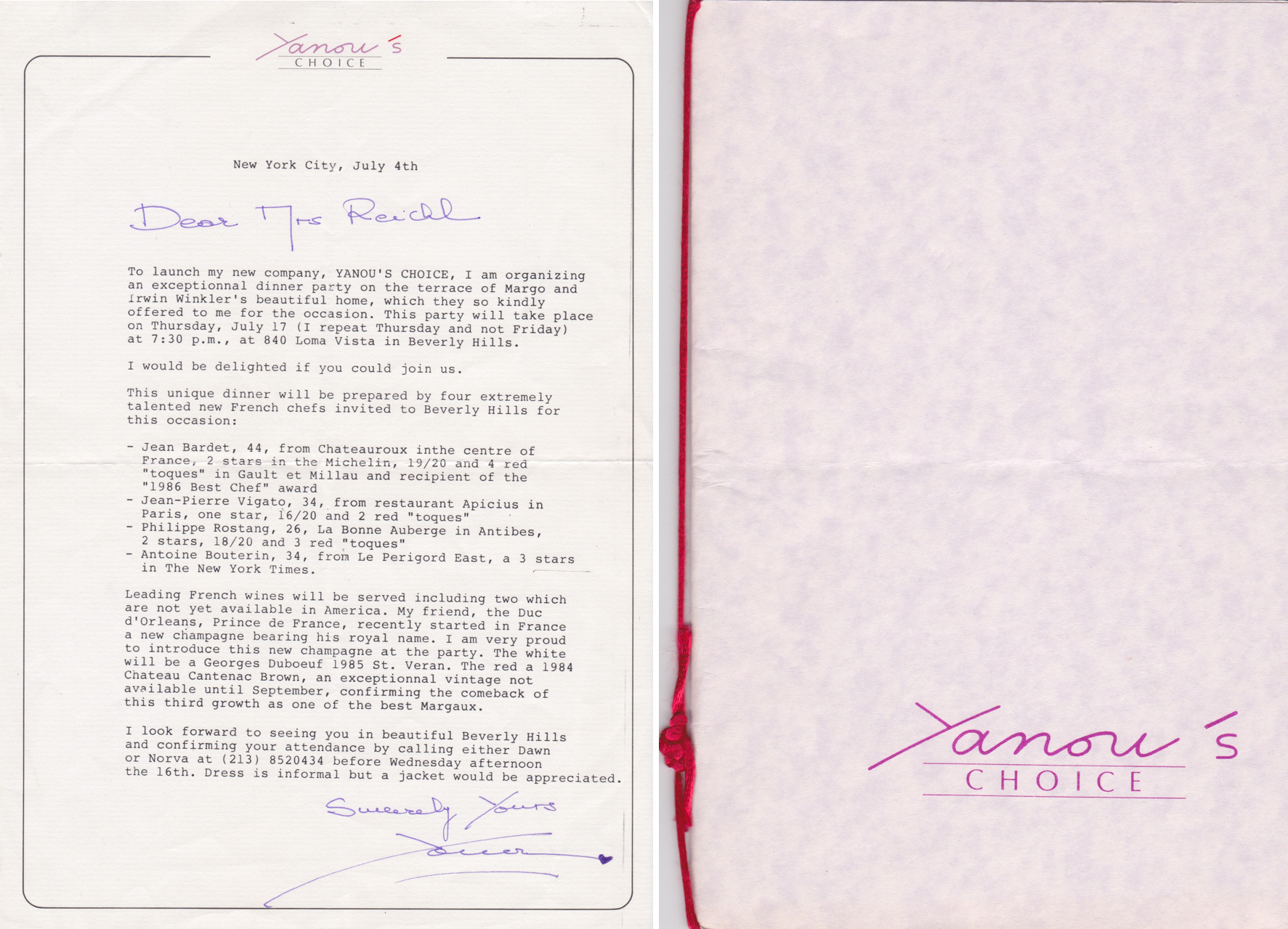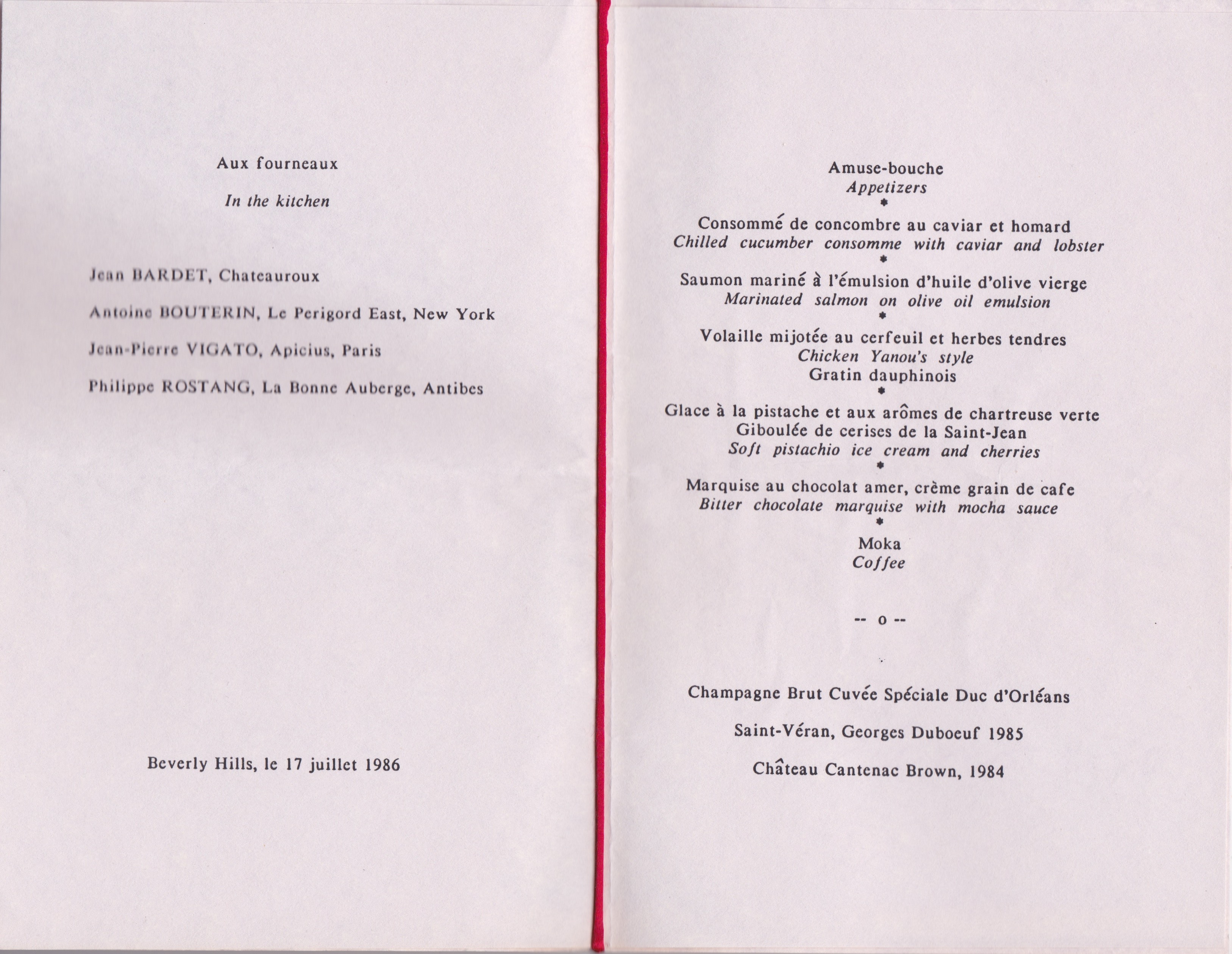What is American Food?
A 30 year old note brings up the question. Also, an old menu that you have never seen, Danny Kaye's favorite pasta and a great source for Indian ingredients.
Whenever I want to illustrate that food is about so much more than recipes and restaurant reviews I pull out a note that I’ve been carrying around — both in my head and literally — for the past thirty years. On March 14, 1991, an irate reader tore off the cover of the Food Section of the Los Angeles Times and scrawled a diatribe across it. She was enraged because we had featured articles about two superb cooks. One was Sri Lankan, the other was learning to cook from her Vietnamese mother-in-law; both featured recipes I’m proud to have published.
“What kind of mentality do the people you employ have!” she wrote. “Disgusting — and stupid — Oriental food during St. Patrick’s celebration which is an American tradition.”
And then, still irate, “I am not Irish, but everyone in the U.S.A. recognizes this day. That is if they are American. They prepare Irish food. Octopus soup has its place, but not on St. Patrick’s day.”
I wrote the woman back, saying that she was correct in saying that this is an American tradition; corned beef and cabbage are not actually eaten in Ireland on St. Patrick’s day. I added that since early Irish immigrants to America tended to live in the same neighborhoods as Jewish immigrants, they bought their brisket for corned beef from Kosher butchers so St. Patrick’s Day might be considered a Jewish tradition as well.
Not surprisingly, I did not hear back.
Thirty years have passed, and things have changed. But we are still trying to prove that we’re American by cooking the “right foods”, and we’re still arguing over what they are. The conversation has intensified in strange ways. In 1991 some people thought that you had to cook corned beef and cabbage on St. Patrick’s Day to prove your patriotism. Today some people wonder whether they have a right to these recipes if they are not of Irish extraction.
As new immigrants arrive on our shores, as they always have, the definition of American food continues to change. What is American? The question brings up very complicated issues. Not so long ago when White chefs cooked Mexican or Chinese food it was considered an homage; today it is sometimes considered theft. I expect our notions about this will evolve.
Consider, for instance, the recent elevation of an entirely new category of food: Chinese-American, Italian-American, Mexican-American, etc. Chefs are creating fancied-up or playful takes on orange chicken, spaghetti and meatballs and hard-shell tacos. Once considered bastardized versions of classic cuisines, they have now become both beloved and respectable. But who is actually entitled to those recipes? Must you be a third generation hyphenate-American before you can claim them as your own? Certainly the communities who bring their flavors and techniques to our country and our tables deserve credit; at what point do those ideas become so wide-spread that they move into the public domain?
I’ve had some uncomfortable brushes with these issues. In 2007 it occurred to me that while Gourmet had published many excellent articles on the food of Mexico, the magazine had never devoted much energy to the rest of Central and South America. We decided to produce an issue about what we today might call Latinx cooking. I’m proud of that issue; it featured moving pieces by Ana Menéndez, Junot Díaz and Rubén García, an interview with Maricel Presilla, and articles on the cooking of Mexico, Puerto Rico, El Salvador and the Dominican Republic. I naively did not think of this as a statement, and was stunned when our mail was filled with vitriol. Letter after letter howled, “Keep your politics out of my magazine.” On its face, there was hardly a “political” word in the magazine. But the readers sensed that its very existence was a political statement. And to a degree, they were right.
But I had always believed that food is political. And that when we ask, “What is American food?” we are not asking what’s for dinner. We’re asking who we are.
So yes, Mrs. Phillips. Octopus soup does have a place at the table. But today we’d probably also be asking about the provenance of the octopus. Who fished it? What were they paid? And should we even be eating these smart, graceful creatures in the first place? When I consider that long-ago letter, it underscores, for me, that food —and all the issues around it — contains the entire world.
I would like to say that I’m a person with a deep respect for history, and that explains why I’ve saved these old menus. But the truth is that I’m really a packrat; I save everything. It doesn’t always turn out well, but when it comes to menus, I seem to have collected a fascinating historical record of American restaurants over the past fifty years.
A lot of them are menus you could probably find elsewhere. Not this one. My guess is that no one else Yanou Collart invited to this 1987 dinner bothered to save their menu.
Yanou is a remarkable creature: an actress, she was also a proto-foodie who turned herself into a public relations person for famous chefs. This worked because Yanou knew absolutely everyone. I remember this meal as a delicious star-studded production. To my delight I found myself sitting down with Barbra Streisand, Bette Midler and Danny Kaye…to name just a few. Here’s my article about the dinner.
I also think the table favors were Hermes bracelets. Can that be right? I remember it mostly because I had never seen one before, and when I offered it to a friend she replied, “Do you have any idea what that thing is worth?”
Reading this menu made me think of Danny Kaye, who was one of the most extraordinary cooks I’ve ever encountered. (If you’ve never seen Danny singing with Louis Armstrong, you’re in for a treat.)
Danny was famous for his Chinese cooking, but the first dish he ever made for me was this tart, rich, creamy concoction from the Amalfi Coast.
Lemon Pasta
½ stick (¼cup) unsalted butter
1 cup heavy cream
3 tablespoons fresh lemon juice
1 pound fresh egg fettuccine
2 teaspoons fresh lemon zest
salt
freshly ground pepper
freshly grated Parmesan cheese
Melt butter in a deep heavy 12 inch skillet and stir in the cream and lemon juice. Remove the skillet from the heat and keep it warm and covered.
Cook the pasta in a large pot of salted boiling water until al dente, 2-3 minutes.
Reserve ½ cup of the pasta cooking liquid and drain the pasta into a colander.
Add the pasta to the skillet with lemon zest and 2 tablespoons of the pasta cooking liquid and toss well. (Add more pasta cooking liquid 1 tablespoon at a time, if necessary to thin the sauce.)
Season the pasta with salt and pepper and serve with Parmesan cheese.
Serves 4
Click HERE for a printable recipe
If you’ve ever tried to find good mangos in the supermarket you know that it is generally an exercise in frustration. And if you’re looking for an Alphonso mango (generally considered the best of the 1500 different varieties), you’re out of luck.
You can sometimes find them canned, but they tend to have added sugar. This organic Mango puree from Pure Indian Foods contains nothing but mangoes (they say there are about 5 in each jar).
It is silky, sweet, slightly tart and utterly delicious. It’s great for making mango lassi, for adding to various sauces (think barbecue), for spreading on toast or topping ice cream. And while you’re at it, if you’re in the market for Indian ingredients, this is a terrific site.













I love reading La Briffe. Your commentary is beautiful and relatable. I appreciate the many other food writings I see and read, but, frankly, sometimes I find them repetitive and almost tiring. But I never feel that way about yours. Thank you, Ruth!
Louis and Danny's Joy and your correspondence-Brightening this morning! Your commentary on the politicization of food is so clear and right on. It very much helps locate why half the country is swept away by the ravings of a dictator-racism, both conscious and unconscious. Sharing delicious food from a myriad of foreign place opens so many new doors for the heart and mind. Thank you for stirring the pot in such a beautiful way.